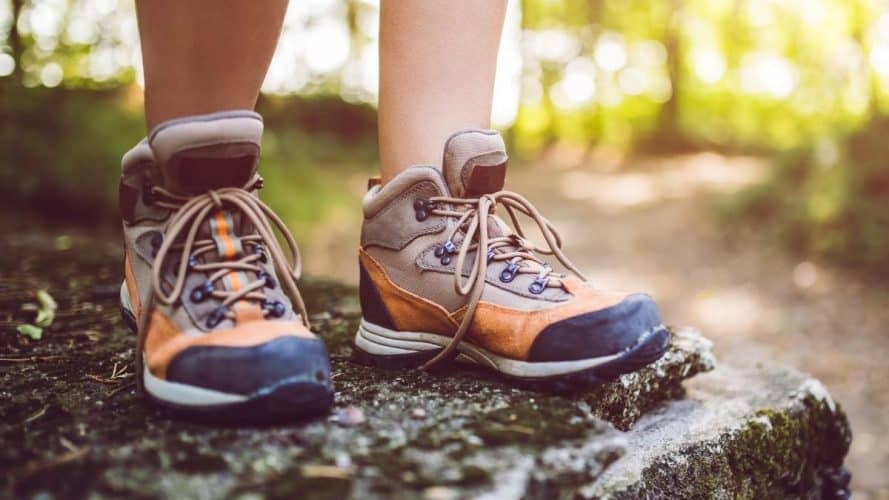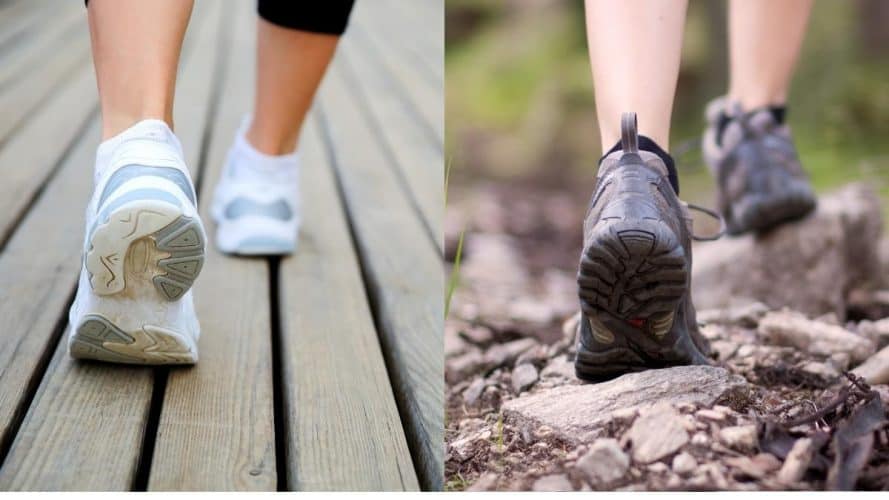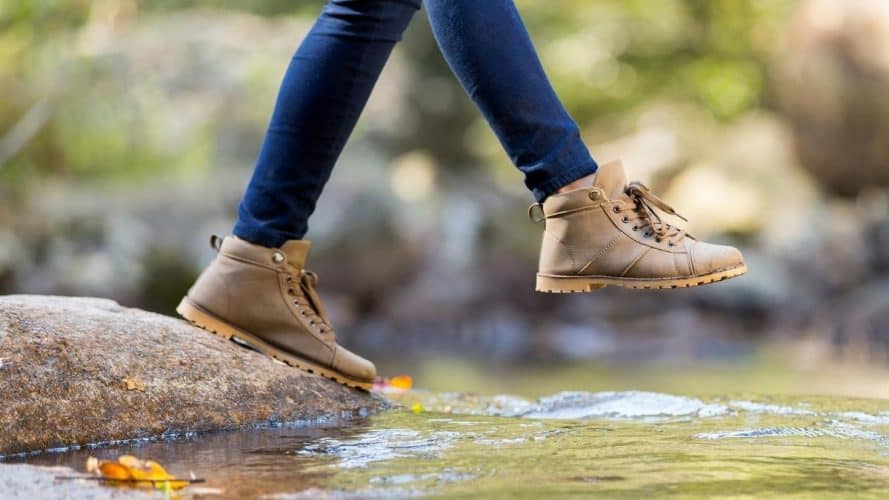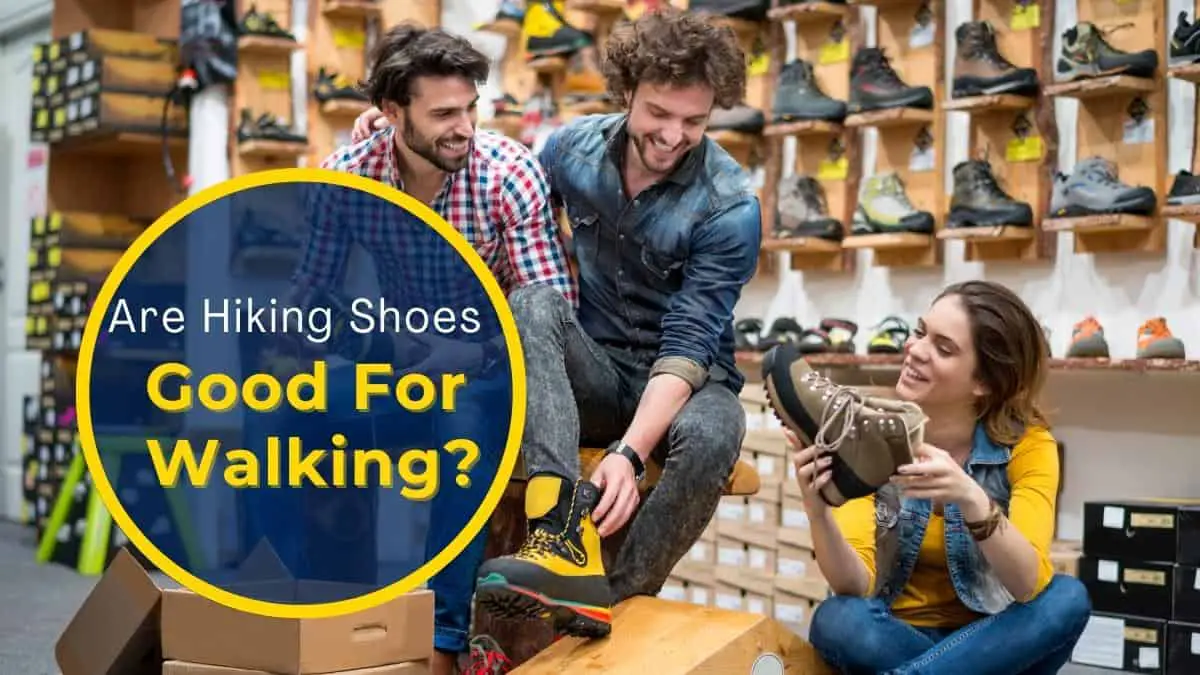Are Hiking Shoes Good For Walking?
So you want to know if hiking shoes are good for walking? Since hiking is just walking on dirt, the answer is a resounding yes, but it comes with certain caveats. Hiking shoes are heavier and are usually warmer than lightweight walking shoes.
Whether for training for hikes or just to clear your mind, it’s common knowledge that walking is good for you. The question we get asked a lot is whether hiking shoes are good for walking around town.
If you are walking on sidewalks and paved trails, hiking shoes are a suitable choice of footwear even if you don’t need many of the features they boast. The extra traction and support are usually overkill for walking in town but come in handy on long walks or if you want to cut through some trails.
In fact, hiking shoes are my personal choice when I need to spend the day walking around. I work in a big box outdoor store with concrete floors and average 15,000 steps per day. If I wear any other shoes, I find my feet and back sore by the end of the day.
But this isn’t the only question people are asking. Check out if hiking shoes are good for running.
Table of Contents
- What is a Hiking Shoe
- Differences Between Hiking Shoes and Walking Shoes
- Advantages of Walking in Hiking Shoes
- Disadvantages of Walking in Hiking Shoes
- Who Would Benefit From Walking in Hiking Shoes
What is a Hiking Shoe
Hiking shoes have a rugged rubber sole for traction and foot protection. This tread is designed to bite into the dirt and give friction on exposed rock.

They will have a high level of cushion like a running shoe but will be stiffer to offer more support on rough terrain. Many models of hiking shoes will have a plate or shank molded into the midsole or cushion to provide increased stability and underfoot protection from rocks or other sharp objects.
The tread will wear down quicker when walking on pavement compared to hiking trails. Since hiking shoes tend to cost more than many walking or running shoes, this may be a factor for you if you are price-conscious. Even with that in mind the tread will tend to last longer than a walking shoe as it is thicker.
The upper will be heavier to protect your feet from kicking rocks and increase the stability of your foot on uneven terrain.
Many hiking shoes also have a waterproof option with a membrane liner that keeps water out but allows some of your sweat to evaporate and escape from the shoe.
This means that hiking shoes will make your feet hotter. This can be welcome in cool weather but uncomfortable in the heat of summer.
If you choose to use hiking shoes in hot weather, we recommend looking at non-waterproof models with a lot of venting. This will minimize the risk of excessive sweating. Wet skin becomes soft, increasing the risk of blisters on long walks.
The extra foot protection and support of a hiking shoe will make it more comfortable to carry weight like a backpack or if you are on the heavier side. They also will give you more stability if you have a history of ankle or knee injuries.
The more stable your feet are, the more support everything above will have. For me, the support is important due to the lower back and hip issues I deal with.
For people who sit a lot for their work, we would recommend hiking shoes for walking as the stabilizer muscles don’t get as much training as people who are on their feet all day would receive.
Modern life has led to many people being inactive for most of the day and then getting their activity in large doses before or after work. This may be why we see record numbers of people with orthopedic health issues.
Ideally, we would have little bits of movement regularly throughout the day so the body is always ready to move. Going from the stiffness that comes from long bouts of sitting to a high activity level is hard on the muscles and joints. A bit of light warming up with dynamic stretching will help reduce the risk of injury and prime your body for movement.
To get an idea of how long your hiking shoes will last and how to look after them, check out our article How Long Do Hiking Boots Last?
Differences Between Hiking Shoes and Walking Shoes

Walking shoes tend to be lighter than hiking shoes with a smoother sole. The lighter weight will mean you walk a little faster for the same effort or expend less energy for the same speed.
This can be a good or bad feature depending on what you hope to get from your walking. Heavier footwear will cause you to burn extra calories, which can be beneficial if your goal is to lose weight.
They offer adequate traction on pavement but don’t have the deep lugs to bite into the dirt on steep hills. This decreased tread depth and density reduce the amount of underfoot protection, so you are more likely to feel sharp rocks and roots. This doesn’t tend to be an issue if you use them on the surfaces they were designed for.
Walking shoes will have a softer cushion, similar to running shoes, for a comfortable walk. This cushion tends to break down quicker than the firmer cushion of a hiking shoe, decreasing the lifespan of the footwear.
Since most walking shoes are based on running-shoe designs, they tend to have a lighter upper, which will be cooler in hot weather.
Hiking shoes, especially waterproof models, are quite warm and will lead and wet feet due to sweat. This will increase the risk of blisters during long walks, more so if the streets are hilly with steep ups and downs.
Advantages of Walking in Hiking Shoes
The extra support will help keep the stabilizer muscles from fatiguing as much, especially on longer walks. This will reduce the risk of overuse injuries, particularly if you are prone to ankle or knee issues.
If you’ve sprained your ankles in the past, it would be smart to wear more supportive footwear even when walking in the city, as curbs and uneven pavement pose similar obstacles as roots and rocks. When walking on the streets, we don’t tend to pay attention to where we place our feet as closely as we do when hiking rugged trails.
Hiking shoes also give you options to head offroad onto trails if you have them in the area you are walking. While we walk mainly on sidewalks and paved trails near our house, there are a few trails through the forest with some steep hills and roots.
Waterproof hiking shoes are better for walking when it is cold and wet out. In late fall and early spring, the hiking shoes give a level of warmth and dryness that make walking in less than pleasant conditions comfortable.
Hiking shoes tend to last longer than walking shoes. While the tread will wear down quicker on pavement than on the trail, since it is thicker, you will get more walking miles out of hiking shoes before they need to be retired.
Many of my hiking shoes are still great for walking around town, even after the lugs on the sole are worn down too much for traction in loose dirt.
Disadvantages of Walking in Hiking Shoes
Hiking shoes tend to weigh more than walking shoes, especially the more supportive options. This will tend to be more fatiguing.
The hip flexor muscles at the top of your thigh can feel it if you are walking longer than usual. Over stressed hip flexors can lead to lower back pain so if you are susceptible then this will be a consideration for you.
Hiking shoes tend to be warmer. This is an advantage when it is cold but in the heat of summer, especially when humid can be both uncomfortable and lead to blisters.
In the summer I wear mesh topped trail running shoes for walking and hiking. I give up a little bit of support and durability but they are much cooler and my feet don’t get as wet from sweat.
Quality hiking shoes tend to be fairly expensive so it budget is a concern then walking shoe can save you a bit of money upfront. Since hiking shoes will tend to last longer it is hard to say which is the better value over the long term.
Who Would Benefit From Walking in Hiking Shoes

- People who want just one pair of shoes for all of their walking, whether on the street or on the trail.
- Those who mix pavement and trails on the same walk. Wear the shoes that will handle the roughest terrain you expect to encounter.
- Walkers in need of more support. The increased underfoot protection and foot stability will help people with ankle, knee and lower back issues.
- Older walkers. As we age we lose strength and stability. By improving the support at your feet it will help keep us walking longer. If you are finding balance an issue while walking consider adding trekking poles in addition to hiking shoes.

